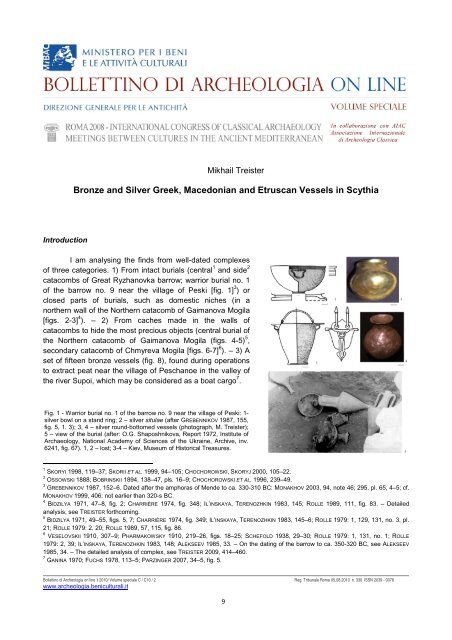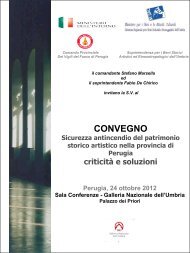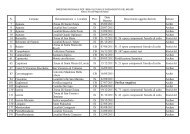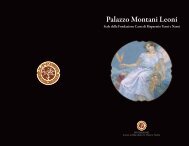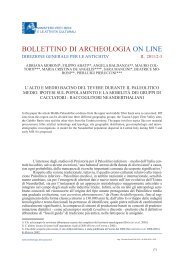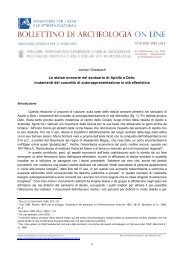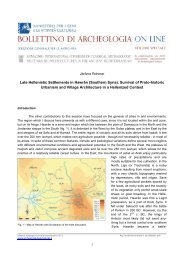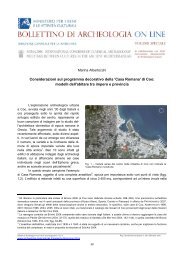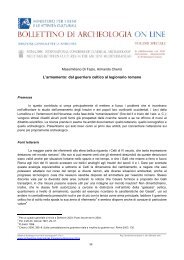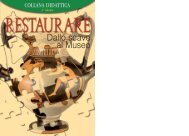Bronze and Silver Greek, Macedonian and Etruscan Vessels in ...
Bronze and Silver Greek, Macedonian and Etruscan Vessels in ...
Bronze and Silver Greek, Macedonian and Etruscan Vessels in ...
You also want an ePaper? Increase the reach of your titles
YUMPU automatically turns print PDFs into web optimized ePapers that Google loves.
Introduction<br />
Mikhail Treister<br />
<strong>Bronze</strong> <strong>and</strong> <strong>Silver</strong> <strong>Greek</strong>, <strong>Macedonian</strong> <strong>and</strong> <strong>Etruscan</strong> <strong>Vessels</strong> <strong>in</strong> Scythia<br />
I am analys<strong>in</strong>g the f<strong>in</strong>ds from well-dated complexes<br />
of three categories. 1) From <strong>in</strong>tact burials (central 1 <strong>and</strong> side 2<br />
catacombs of Great Ryzhanovka barrow; warrior burial no. 1<br />
of the barrow no. 9 near the village of Peski [fig. 1] 3 ) or<br />
closed parts of burials, such as domestic niches (<strong>in</strong> a<br />
northern wall of the Northern catacomb of Gaimanova Mogila<br />
[figs. 2-3] 4 ). – 2) From caches made <strong>in</strong> the walls of<br />
catacombs to hide the most precious objects (central burial of<br />
the Northern catacomb of Gaimanova Mogila (figs. 4-5) 5 ,<br />
secondary catacomb of Chmyreva Mogila [figs. 6-7] 6 ). – 3) A<br />
set of fifteen bronze vessels (fig. 8), found dur<strong>in</strong>g operations<br />
to extract peat near the village of Peschanoe <strong>in</strong> the valley of<br />
the river Supoi, which may be considered as a boat cargo 7 .<br />
Fig. 1 - Warrior burial no. 1 of the barrow no. 9 near the village of Peski: 1-<br />
silver bowl on a st<strong>and</strong> r<strong>in</strong>g; 2 – silver situlae (after GREBENNIKOV 1987, 155,<br />
fig. 5, 1. 3); 3, 4 – silver round-bottomed vessels (photograph, M. Treister);<br />
5 – view of the burial (after: O.G. Shaposhnikova, Report 1972, Institute of<br />
Archaeology, National Academy of Sciences of the Ukra<strong>in</strong>e, Archive, <strong>in</strong>v.<br />
6241, fig. 67). 1, 2 – lost; 3-4 – Kiev, Museum of Historical Treasures.<br />
1<br />
SKORYI 1998, 119–37; SKORII ET AL. 1999, 94–105; CHOCHOROWSKI, SKORYJ 2000, 105–22.<br />
2<br />
OSSOWSKI 1888; BOBRINSKII 1894, 138–47, pls. 16–9; CHOCHOROWSKI ET AL. 1996, 239–49.<br />
3<br />
GREBENNIKOV 1987, 152–6. Dated after the amphoras of Mende to ca. 330-310 BC: MONAKHOV 2003, 94, note 46; 295, pl. 65, 4–5; cf.<br />
MONAKHOV 1999, 406: not earlier than 320-s BC.<br />
4<br />
BIDZILYA 1971, 47–8, fig. 2; CHARRIÈRE 1974, fig. 348; IL’INSKAYA, TERENOZHKIN 1983, 145; ROLLE 1989, 111, fig. 83. – Detailed<br />
analysis, see TREISTER forthcom<strong>in</strong>g.<br />
5<br />
BIDZILYA 1971, 49–55, figs. 5, 7; CHARRIÈRE 1974, fig. 349; IL’INSKAYA, TERENOZHKIN 1983, 145–6; ROLLE 1979: 1, 129, 131, no. 3, pl.<br />
21; ROLLE 1979: 2, 20; ROLLE 1989, 57, 115, fig. 86.<br />
6<br />
VESELOVSKII 1910, 307–9; PHARMAKOWSKY 1910, 219–26, figs. 18–25; SCHEFOLD 1938, 29–30; ROLLE 1979: 1, 131, no. 1; ROLLE<br />
1979: 2, 39; IL’INSKAYA, TERENOZHKIN 1983, 148; ALEKSEEV 1985, 33. – On the dat<strong>in</strong>g of the barrow to ca. 350-320 BC, see ALEKSEEV<br />
1985, 34. – The detailed analysis of complex, see TREISTER 2009, 414–460.<br />
7 GANINA 1970; FUCHS 1978, 113–5; PARZINGER 2007, 34–5, fig. 5.<br />
Bollett<strong>in</strong>o di Archeologia on l<strong>in</strong>e I 2010/ Volume speciale C / C10 / 2 Reg. Tribunale Roma 05.08.2010 n. 330 ISSN 2039 - 0076<br />
www.archeologia.beniculturali.it<br />
9
M. Treister – <strong>Bronze</strong> <strong>and</strong> <strong>Silver</strong> <strong>Greek</strong>, <strong>Macedonian</strong> <strong>and</strong> <strong>Etruscan</strong> <strong>Vessels</strong> <strong>in</strong> Scythia<br />
Fig. 2 - Domestic niche <strong>in</strong> the north wall of the<br />
Northern catacomb of Gaimanova Mogila: 1 –<br />
view of the niche (after BIDZILYA 1971, 47, fig.<br />
2); 2 – amphoras from the niche (after<br />
MONAKHOV 1999, pls. 172-173).<br />
Fig. 4 - <strong>Vessels</strong> from the cache of the central burial<br />
of the Northern catacomb of Gaimanova Mogila: 1 –<br />
Analysis view of the of cache Various (after Categories ROLLE 1989, 115, of Imported fig. 86); Metalware<br />
general view of the f<strong>in</strong>ds (after BIDZILYA 1971, 50,<br />
fig. 5).<br />
Bollett<strong>in</strong>o di Archeologia on l<strong>in</strong>e I 2010/ Volume speciale C / C10 / 2 Reg. Tribunale Roma 05.08.2010 n. 330 ISSN 2039 - 0076<br />
www.archeologia.beniculturali.it<br />
10<br />
Fig. 3 - <strong>Bronze</strong> vessels from the northern wall of the<br />
Northern catacomb of Gaimanova Mogila. Kiev, State<br />
Museum of Historical Treasures. Photographs, M.<br />
Treister, 2004.<br />
Fig. 5 - <strong>Vessels</strong> from the cache of the central burial of<br />
the Northern catacomb of Gaimanova Mogila Kiev,<br />
State Museum of Historical Treasures. Photographs,<br />
M. Treister, 2007.
Fig. 6 - <strong>Silver</strong> vessels from the cache of Chmyreva Mogila. State<br />
Hermitage till 1932; Kharkov Museum, 1932-1941. Lost dur<strong>in</strong>g<br />
the World War II. 1-2, 4-6 - after the negatives, kept <strong>in</strong> the<br />
photoarchive, Institute of Material Culture, St. Petersburg; 3 –<br />
after ONAIKO 1970, pl. XIV, no. 398.<br />
XVII International Congress of Classical Archaeology, Roma 22-26 Sept. 2008<br />
Session: Tracia e Dacia<br />
The ma<strong>in</strong> categories of the imported bronze <strong>and</strong> silver vessels <strong>in</strong> Scythia under discussion are<br />
situlae, kraters, hemispherical bowls on st<strong>and</strong>-r<strong>in</strong>gs, bas<strong>in</strong>s, braziers <strong>and</strong> o<strong>in</strong>ochoai.<br />
Situlae<br />
A bronze kalathos situla from Gaimanova Mogila (fig. 3, 1 right) 8 belongs to the rare variant of<br />
kalathos situlae with concave body 9 , of which only 5 pieces (fig. 9) were known before: one from Thrace<br />
(Orizovo 10 ), <strong>and</strong> four – from <strong>Macedonian</strong> tombs A 11 <strong>and</strong> B 12 at Derveni).<br />
It is worth not<strong>in</strong>g, that the f<strong>in</strong>d from Gaimanova Mogila is the only kalathos situla <strong>in</strong> Scythia, whereas<br />
related bronze bell or ovoid situlae (fig. 10), the type which also widespread primarily <strong>in</strong> Macedonia 13 <strong>and</strong><br />
Thrace 14 <strong>in</strong> the second half of the 4 th century BC, is represented by the fragmentary f<strong>in</strong>ds from<br />
8<br />
TREISTER 2006, 144, fig. 6.<br />
9<br />
See ZAHLHAAS 1971, 74–87 (type B); PFROMMER 1983, 251–52, fig. 9; ARCHIBALD 1998, 189–90, 275–76; BARR-SHARRAR 2000, 280–<br />
81; BARR-SHARRAR 2002, 70–2; PELLEGRIS 2004, 359–60.<br />
10<br />
TSONCHEV 1948, 19, No. 1; 20, fig. 4; VENEDIKOV 1977, 99, No. 11; 80, fig. 31; ARCHIBALD 1998, 275–76, note 46; 329; BARR-<br />
SHARRAR 2000, 280–81.<br />
11<br />
THEMELIS, TOURATSOGLOU 1997, 33–4, nos. A48–A50, pls. 3; 35–7.<br />
12<br />
BARR-SHARRAR 1982, 130–31, fig. 16; THEMELIS, TOURATSOGLOU 1997, 73, no. B28, pls. 18, 78; BARR-SHARRAR 2008, 23, fig. 18.<br />
13<br />
See, e.g., Derveni: THEMELIS, TOURATSOGLOU 1997, pls. 111, ∆4, 6; 134, Z15; BARR-SHARRAR 2000, 282; Nikisiani, tomb A-Γ:<br />
LAZARIDIS ET AL. 1992, 42–3, A 2580, fig. 14, pl. 27.<br />
14 Vratsa: PAUNOV, TORBOV 2000, 167, fig. 3.<br />
Bollett<strong>in</strong>o di Archeologia on l<strong>in</strong>e I 2010/ Volume speciale C / C10 / 2 Reg. Tribunale Roma 05.08.2010 n. 330 ISSN 2039 - 0076<br />
www.archeologia.beniculturali.it<br />
11<br />
Fig. 7 - <strong>Silver</strong> vessels from the cache of Chmyreva Mogila. State<br />
Hermitage till 1932; Kharkov Museum, 1932-1941. Lost dur<strong>in</strong>g<br />
the World War II. Photographs after the negatives, kept <strong>in</strong> the<br />
photoarchive, Institute of Material Culture, St. Petersburg.
M. Treister – <strong>Bronze</strong> <strong>and</strong> <strong>Silver</strong> <strong>Greek</strong>, <strong>Macedonian</strong> <strong>and</strong> <strong>Etruscan</strong> <strong>Vessels</strong> <strong>in</strong> Scythia<br />
Fig. 8 - <strong>Bronze</strong> vessels from Peschanoe. Kiev, National Museum of History of the Ukra<strong>in</strong>e. 1 – photograph, M. Treister, 2007; 2 – after<br />
PARZINGER 2007, 34, fig. 5.<br />
Bollett<strong>in</strong>o di Archeologia on l<strong>in</strong>e I 2010/ Volume speciale C / C10 / 2 Reg. Tribunale Roma 05.08.2010 n. 330 ISSN 2039 - 0076<br />
www.archeologia.beniculturali.it<br />
12
Fig. 9 - Map. Distribution of bronze kalathos situlae. M.<br />
Treister, 2008.<br />
XVII International Congress of Classical Archaeology, Roma 22-26 Sept. 2008<br />
Session: Tracia e Dacia<br />
Karagodeuashkh (fig. 11, 3) 15 , Tishkovo (fig. 11, 4) 16 <strong>and</strong> Chertomlyk (fig. 11, 2) 17 <strong>and</strong> a complete piece from<br />
Peschanoe (fig. 11, 1) 18 .<br />
Also popular <strong>in</strong> Scythia (fig. 12) were bronze stamnoid situlae, with the spout decorated with a lion<br />
head (type С, after G. Zahlhaas 19 ), the f<strong>in</strong>ds of which orig<strong>in</strong>ate from the central 20 <strong>and</strong> side 21 catacombs of<br />
Great Ryzhanovka barrow, аs well as from Peschanoe (fig. 13) 22 . All these situlae have almost identical<br />
spouts shaped as lion’ heads. Very similar parallels to these may be found on the situlae of the same shape<br />
from Derveni tombs A 23 , B 24 , Verg<strong>in</strong>a tomb II (<strong>in</strong> silver) 25 , Nikesiani grave E 26 , tomb of the Northern cemetery<br />
of Pydna 27 , tomb no. 3 at Methone 28 . Not only the spouts but also details of the shape of the both situlae<br />
from Ryzhanovka barrow correspond with the f<strong>in</strong>ds from Macedonia. The h<strong>and</strong>le attachment <strong>in</strong> the form of<br />
the bust of the helmeted Athena on the situla from Peschanoe (fig. 13, 4) f<strong>in</strong>ds parallels (fig. 14) only on few<br />
15<br />
LAPPO-DANILEVSKII, MALMBERG 1894, 45, fig. 13; ONAIKO 1970, 21.<br />
16<br />
ONAIKO 1970, 115, no. 764, pl. XVII; SHEFTON 1994, 584, 592, no. 2; SKORYI 1998, 126.<br />
17<br />
ONAIKO 1970, 21, no. 408; ROLLE, MURZIN, ALEKSEEV 1998, 1: 150; ROLLE, MURZIN, ALEKSEEV 1998, 2–3: 27, no. 157, pl. 44, 2.<br />
18<br />
GANINA 1970, 48–50, 89–90, figs. 18, 46; Cat. SAN ANTONIO 1999, no. 87.<br />
19<br />
ZAHLHAAS 1971, 96–107; BARR-SHARRAR 1982, 129–30; PFROMMER 1983, 250–62; CANDELA 1985, 25–42; ZIMMERMANN 1998, 47–54.<br />
20<br />
SKORYI 1998, 125–6; SKORYI ET AL. 1999, 99; CHOCHOROWSKI, SKORYJ 2000, 107; SKORYI 2000, 123.<br />
20<br />
SKORYI 1999, 99; CHOCHOROWSKI, SKORYJ 2000, 107; SKORYI 2000, 123.<br />
21<br />
BOBRINSKII 1894, 141, 145–6, pl. XIX, 5–7; ONAIKO 1970, 115, no. 765, pl. 33; ZAHLHAAS 1971, 90, no. C7; SKORYI 1998, 125–126;<br />
SKORYI 2000, 123.<br />
22<br />
GANINA 1970, 68–71, 90, figs. 19-22, 30; ZAHLHAAS 1971, 92, no. C18; BOUCHER 1973, 94–5, figs. 18-20; GANINA 1974, fig. 20; Cat.<br />
NEW YORK 1975, no. 179; CANDELA 1985, 31, no. 43; 34, figs. 25–6; 42–3; Cat. SCHLESWIG 1991, no. 103f; Cat. VIENNA 1993, no. 65;<br />
Cat. SAN ANTONIO 1999, no. 85.<br />
23<br />
ZAHLHAAS 1971, 89, no. C4; Cat. THESSALONIKI 1978, 57, no. 158; CANDELA 1985, 27, no. 2, fig. 1; 34; THEMELIS, TOURATSOGLOU<br />
1997, 33, no. A 2, pls. 2, 34; Cat. HANOVER 1994, 225, no. 262.<br />
24<br />
Cat. THESSALONIKI 1978, 64, no. 212; CANDELA 1985, 27, no. 3; 34; THEMELIS, TOURATSOGLOU 1997, 73, no. B 29, pl. 79; Cat. NEW<br />
YORK 2004, 79, no. 6.<br />
25<br />
Cat. THESSALONIKI 1978, 52, no. 112; ANDRONICOS 1984, 146–7, figs. 104–5; CANDELA 1985, 27, no. 1; 34.<br />
26 BOUCHER 1973, 91, 93, fig. 16; Cat. WASHINGTON 1980, 161, no. 122, col. pl. 18; BARR-SHARRAR 1982, 129–30, fig. 14; LAZARIDIS ET<br />
AL. 1992, 27, A1403, pl. A; Cat. HANOVER 1994, 241, no. 305.<br />
27 BESSIOS, PAPPA 1995, pl. 83A.<br />
28 BESSIOS, PAPPA 1995, pl. 83B.<br />
Bollett<strong>in</strong>o di Archeologia on l<strong>in</strong>e I 2010/ Volume speciale C / C10 / 2 Reg. Tribunale Roma 05.08.2010 n. 330 ISSN 2039 - 0076<br />
www.archeologia.beniculturali.it<br />
13<br />
Fig. 10 - Map. Distribution of bronze ovoid situlae. M. Treister,<br />
2008.
M. Treister – <strong>Bronze</strong> <strong>and</strong> <strong>Silver</strong> <strong>Greek</strong>, <strong>Macedonian</strong> <strong>and</strong> <strong>Etruscan</strong> <strong>Vessels</strong> <strong>in</strong> Scythia<br />
Fig. 11 - <strong>Bronze</strong> ovoid situlae: 1 – Peschanoe; 2 – Chertomlyk; 3<br />
– Karagodeuashkh; 4 – Tishkovo. 1- Kiev, National Museum of<br />
History of the Ukra<strong>in</strong>e; 2-4 – St. Petersburg, State Hermitage. 1 –<br />
after Cat. SAN ANTONIO 1999, no. 87; 2 – after ROLLE, MURZIN,<br />
ALEKSEEV 1998, pl. 44, 2; 3 – after LAPPO-DANILEVSKII, MALMBERG<br />
1894, 45, fig. 13; 4 – after ONAIKO 1970, pl. XVII, no. 764.<br />
Bollett<strong>in</strong>o di Archeologia on l<strong>in</strong>e I 2010/ Volume speciale C / C10 / 2 Reg. Tribunale Roma 05.08.2010 n. 330 ISSN 2039 - 0076<br />
www.archeologia.beniculturali.it<br />
14<br />
examples from Western Macedonia (Tsotylion 29 ),<br />
Thrace (Slavjane 30 <strong>and</strong> the vic<strong>in</strong>ities of Kazanlyk 31 )<br />
<strong>and</strong> allegedly from Dodona 32 .<br />
On this background dist<strong>in</strong>guishes a silver<br />
situla of the same shape with a spout, which is<br />
fixed with a lower attachment <strong>in</strong> the form of a leaf<br />
<strong>and</strong> a support <strong>in</strong> the form of a bent rod, with a<br />
h<strong>and</strong>le on the opposite side of the body, found <strong>in</strong> the burial no. 1 of the barrow no. 9 near the village of Peski<br />
(fig. 1, 3) 33 . <strong>Bronze</strong> situlae with similarly shaped spout <strong>and</strong> h<strong>and</strong>les orig<strong>in</strong>ate from the first half of the 4 th<br />
century BC grave II <strong>in</strong> Kozani, Macedonia 34 <strong>and</strong> from the mid-4 th century BC burial no. 166 of the Vitsa<br />
necropolis <strong>in</strong> Epirus 35 . These situlae belong to the earliest group of type C 36 .<br />
Kraters<br />
Two similar bronze kraters orig<strong>in</strong>ate from the central catacomb of Great Ryzhanovka barrow 37 <strong>and</strong><br />
from Peschanoe (fig. 15) 38 . Close parallels were found only <strong>in</strong> Macedonia <strong>and</strong> Thrace (fig. 16): <strong>in</strong> the tombs<br />
29<br />
ZAHLHAAS 1971, 92, no. C16; BOUCHER 1973, 91–2, fig. 14; PFROMMER 1983, 253; CANDELA 1985, 27, no. 4, fig. 20; 41; ZIMMERMANN<br />
1998, 165, STM 13.<br />
30<br />
VENEDIKOV, GERASSIMOV 1973, pl. 109; CANDELA 1985, 30, no. 37; 42–3, figs. 27, 30.<br />
31<br />
VENEDIKOV, GERASSIMOV 1973, pl. 110; CANDELA 1985, 30, no. 38; 42–3.<br />
32<br />
ZAHLHAAS 1971, 92, no. C17; CANDELA 1985, 28, no. 8; Cat. VIENNA 1986, 70–1, no. 67, figs. 132–3.<br />
33<br />
GREBENNIKOV 1987, 155, fig. 5, 3; 156, no. 20.<br />
34<br />
Cat. THESSALONIKI 1978, 41, no. 36, pl. 8; BARR-SHARRAR 1982, 129–30, fig. 13; BARR-SHARRAR 1986, 81, fig. 3; ZIMMERMANN 1998,<br />
165, STM 2.<br />
35<br />
VOKOTOPOULOU 1986, 186–7, no. 2; 289, pl. 297, fig. 82c; ZIMMERMANN 1998, 165, STM 3. On the <strong>in</strong>ventoty of the tomb <strong>and</strong> its<br />
dat<strong>in</strong>g, see VOKOTOPOULOU 1986, 185–8.<br />
36<br />
ZIMMERMANN 1998, 49–50; BARR-SHARRAR 2000, 280.<br />
37<br />
Kiev, Archaeological Museum National Academy of Sciences of the Ukra<strong>in</strong>e, <strong>in</strong>v. АМ 2893/8319. Unpublished.<br />
38 GANINA 1970, 80–1, 93, fig. 28.<br />
Fig. 12 - Map. Distribution of bronze stamnoid situlae. M.<br />
Treister, 2008.
Fig. 13 - <strong>Bronze</strong> stamnoid situla from Peschanoe. Kiev,<br />
National Museum of History of the Ukra<strong>in</strong>e. After Cat. SAN<br />
ANTONIO 1999, no. 85.<br />
Fig. 15 - <strong>Bronze</strong> krater from Peschanoe. Kiev, National Museum of<br />
History of the Ukra<strong>in</strong>e. Photo, courtesy National Museum of History<br />
of the Ukra<strong>in</strong>e, Kiev.<br />
XVII International Congress of Classical Archaeology, Roma 22-26 Sept. 2008<br />
Session: Tracia e Dacia<br />
Bollett<strong>in</strong>o di Archeologia on l<strong>in</strong>e I 2010/ Volume speciale C / C10 / 2 Reg. Tribunale Roma 05.08.2010 n. 330 ISSN 2039 - 0076<br />
www.archeologia.beniculturali.it<br />
15<br />
Fig. 14 - Map. Distribution of bronze stamnoid situlae with<br />
attachments <strong>in</strong> the form of Athena heads. M. Treister, 2008.<br />
Fig. 16 - Map. Distribution of bronze kraters. M. Treister, 2008.
M. Treister – <strong>Bronze</strong> <strong>and</strong> <strong>Silver</strong> <strong>Greek</strong>, <strong>Macedonian</strong> <strong>and</strong> <strong>Etruscan</strong> <strong>Vessels</strong> <strong>in</strong> Scythia<br />
Fig. 17 - Map. Distribution of hemispherical bowls on st<strong>and</strong>r<strong>in</strong>gs<br />
<strong>and</strong> movable h<strong>and</strong>les. M. Treister, 2008.<br />
Bas<strong>in</strong> with a movable h<strong>and</strong>le<br />
Bollett<strong>in</strong>o di Archeologia on l<strong>in</strong>e I 2010/ Volume speciale C / C10 / 2 Reg. Tribunale Roma 05.08.2010 n. 330 ISSN 2039 - 0076<br />
www.archeologia.beniculturali.it<br />
16<br />
A 39 , B 40 <strong>and</strong> Z 41 <strong>in</strong> Derveni, <strong>in</strong> the tomb II at Verg<strong>in</strong>a 42<br />
as well as <strong>in</strong> the Naip tumulus <strong>in</strong> the Propontic<br />
Thrace 43 . These kraters are usually associated with<br />
ritual wash<strong>in</strong>g before the symposium.<br />
Hemispherical bowls on st<strong>and</strong>-r<strong>in</strong>gs <strong>and</strong> movable<br />
h<strong>and</strong>les<br />
Two bronze pieces orig<strong>in</strong>ate from the<br />
central 44 <strong>and</strong> side catacombs 45 of Great Ryzhanovka<br />
barrow; a bronze bowl was found <strong>in</strong> the north burial<br />
of the barrow no. 22 near Arkhangel’skaya sloboda 46 ,<br />
a silver one – <strong>in</strong> the barrow no. 9 near the village<br />
Peski (fig. 1, 1) 47 . Numerous parallels which co<strong>in</strong>cide<br />
also <strong>in</strong> the details of decoration of the rim <strong>and</strong> (or)<br />
the shape of h<strong>and</strong>les orig<strong>in</strong>ate from <strong>Macedonian</strong><br />
burials of the second half of the 4 th century BC (fig.<br />
17), <strong>in</strong>clud<strong>in</strong>g those of Derveni tombs B 48 <strong>and</strong> Z 49 ,<br />
tomb II at Verg<strong>in</strong>a (<strong>in</strong> silver) 50 , tomb E at Nikesiani 51 ,<br />
tomb 20 at Pydna 52 , tomb at Methone 53 , as well as<br />
from Votonosi 54 <strong>and</strong> Vitsa 55 <strong>in</strong> Epirus. A similar bowl<br />
with the lost st<strong>and</strong>-r<strong>in</strong>g <strong>and</strong> loop-h<strong>and</strong>les orig<strong>in</strong>ates<br />
from Vyrbitsa <strong>in</strong> Thrace 56 .<br />
A bronze bas<strong>in</strong> with a movable h<strong>and</strong>le <strong>and</strong> an attachment decorated with an open-worked palmette<br />
from the niche <strong>in</strong> Gaimanova Mogila (figs. 3, 2; 18) 57 f<strong>in</strong>ds the closest parallel both <strong>in</strong> dimensions <strong>and</strong> <strong>in</strong><br />
details of decoration of the palmette attachment <strong>in</strong> the tomb No. 2 of the mid-4 th century BC Thracian<br />
Mogilanska Mogila 58 .<br />
39<br />
Cat. THESSALONIKI 1978, 59, no. 174; Cat. WASHINGTON 1980, 163, no. 126; THEMELIS, TOURATSOGLOU 1997, 31, no. A51, pl. 32;<br />
BARR-SHARRAR 2008, 13, fig. 7.<br />
40<br />
Cat. THESSALONIKI 1978, 65, no. 223; THEMELIS, TOURATSOGLOU 1997, 72–3, no. B40, pl. 77.<br />
41<br />
Cat. THESSALONIKI 1978, 71, no. 265; THEMELIS, TOURATSOGLOU 1997, 122, no. Z18, pl. 132.<br />
42<br />
ANDRONICOS 1984, 160, fig. 127.<br />
43<br />
DELEMEN 2006, 262, 266, fig. 14.<br />
44<br />
Kiev, Archaeological Museum National Academy of Sciences of the Ukra<strong>in</strong>e. Unpublished.<br />
45<br />
BOBRINSKII 1894, 142, 146, pl. XVII, 8; ONAIKO 1970, 116, no. 772, pl. XXXIII.<br />
46<br />
LESKOV 1974, 79, fig. 118; 86.<br />
47<br />
GREBENNIKOV 1987, 155, fig. 5, 1; 156, No. 21.<br />
48<br />
Cat. THESSALONIKI 1978, 63, no. 208; THEMELIS, TOURATSOGLOU 1997, 73, B25, pl. 77.<br />
49<br />
Cat. THESSALONIKI 1978, 71, no. 263; THEMELIS, TOURATSOGLOU 1997, 122–3, Z16, pl. 136.<br />
50<br />
ANDRONICOS 1984, 149, fig. 111.<br />
51<br />
Cat. THESSALONIKI 1978, 97, no. 407, pl. 57; LAZARIDIS ET AL. 1992, 40, A1402, pl. 23.<br />
52<br />
BESSIOS, PAPPA 1995, pl. 86∆; Cat. NEW YORK 2004, 84, no. 19.<br />
53<br />
BESSIOS, PAPPA 1995, pl. 83B.<br />
54<br />
VOKOTOPOULOU 1975, 773, 775, no. 24, fig. 34.<br />
55<br />
VOKOTOPOULOU 1986, 288, no. 4, fig. 83a.<br />
56<br />
FILOW 1934, 176–7, no. 8, fig. 194.<br />
57<br />
Kiev, Museum of Historical Treasures, <strong>in</strong>v. АЗС-2787: TREISTER 2009, 435–9, 448–9, no. 6, figs, 2, 1; 7–10.<br />
58 PAUNOV, TORBOV 2000, 171, fig. 5.
Fig. 18 - <strong>Bronze</strong> bas<strong>in</strong> from Gaimanova Mogila. Kiev, State<br />
Museum of Historical Treasures. Photographs, M. Treister,<br />
2007.<br />
XVII International Congress of Classical Archaeology, Roma 22-26 Sept. 2008<br />
Session: Tracia e Dacia<br />
Brazier<br />
Bollett<strong>in</strong>o di Archeologia on l<strong>in</strong>e I 2010/ Volume speciale C / C10 / 2 Reg. Tribunale Roma 05.08.2010 n. 330 ISSN 2039 - 0076<br />
www.archeologia.beniculturali.it<br />
17<br />
Fig. 19 - <strong>Bronze</strong> brazier from Gaimanova Mogila.<br />
Kiev, State Museum of Historical Treasures.<br />
Photographs, M. Treister, 2007.<br />
A bronze biconical brazier from Gaimanova Mogila (figs.<br />
3, 4; 19) 59 belongs to an extremely rare type, which is<br />
not represented among the f<strong>in</strong>ds from the Scythian<br />
tumuli, with only three parallels known to me, two of<br />
them from Macedonia (fig. 20) 60 , <strong>in</strong>clud<strong>in</strong>g a very similar<br />
brazier found beneath the floor level of a house <strong>in</strong><br />
Olynthus 61 , where it had probably been hidden by the<br />
owner <strong>in</strong> attempt to save it from the loot<strong>in</strong>g <strong>Macedonian</strong><br />
soldiers <strong>in</strong> 348 BC. There is practically no doubt, that<br />
the brazier from Gaimanova Mogila was manufactured<br />
<strong>in</strong> the workshop on the Chalhidike or, <strong>in</strong> broad terms, <strong>in</strong><br />
Macedonia 62 .<br />
59 TREISTER 2006, 115–8, figs. 1–2.<br />
60 The f<strong>in</strong>d from Pella, see OIKONOMOS 1914, 144–5, fig. 11; SIGANIDOU, LILIMPAKI-AKAMATI 1996, 37; TREISTER 2006, 116–7, fig. 4.<br />
61 ROBINSON 1941, 181–2, no. 570a-c, pls. XXXVII–XXXVIII; CAHILL 2002, 49; TREISTER 2006, 115–6, fig. 3.<br />
62 TREISTER 2006, 117.<br />
Fig. 20 - Map. Distribution of bronze braziers. M. Treister, 2008.
M. Treister – <strong>Bronze</strong> <strong>and</strong> <strong>Silver</strong> <strong>Greek</strong>, <strong>Macedonian</strong> <strong>and</strong> <strong>Etruscan</strong> <strong>Vessels</strong> <strong>in</strong> Scythia<br />
Fig. 21 - <strong>Bronze</strong> o<strong>in</strong>ochoe from Gaimanova Mogila. Kiev, State<br />
Museum of Historical Treasures. Photographs, M. Treister,<br />
2007.<br />
Bollett<strong>in</strong>o di Archeologia on l<strong>in</strong>e I 2010/ Volume speciale C / C10 / 2 Reg. Tribunale Roma 05.08.2010 n. 330 ISSN 2039 - 0076<br />
www.archeologia.beniculturali.it<br />
18<br />
O<strong>in</strong>ochoai<br />
An o<strong>in</strong>ochoe with biconical body from<br />
Gaimanova Mogila (figs. 3, 1 top left; 21) 63 have<br />
only four parallels <strong>in</strong> the North <strong>and</strong> East Pontic<br />
area 64 . This type of o<strong>in</strong>ochoe goes back to <strong>Etruscan</strong><br />
‘Schnabelkanne’, s<strong>in</strong>ce the late 5 th or early 4 th<br />
century BC known <strong>in</strong> Macedonia 65 . In Thraco-<strong>Macedonian</strong> area <strong>in</strong> the 4 th century BC a specific variant of<br />
them was locally developed <strong>and</strong> produced (fig. 22). Six silver <strong>and</strong> bronze vessels of this shape <strong>and</strong> one clay<br />
imitation were found <strong>in</strong> the <strong>Macedonian</strong> burials of the second half of the 4 th – early 3 rd century BC 66 , <strong>in</strong>clud<strong>in</strong>g<br />
two f<strong>in</strong>ds from Tomb A <strong>in</strong> Derveni 67 . Six bronze o<strong>in</strong>ochoai orig<strong>in</strong>ate from the burials <strong>in</strong> Thrace, dated from the<br />
second quarter to the middle of the 4 th century BC 68 , whereas one piece was found <strong>in</strong> the late 4 th century BC<br />
Naip tumulus 69 . A similar bronze o<strong>in</strong>ochoe was found <strong>in</strong> a burial of the Getic necropolis of Zimnicea, dated by<br />
a stamped amphora of Heraklea Pontica to ca. 330-300 BC 70 .<br />
63 TREISTER 2006, 117, fig. 5.<br />
64 Barrow No. 6 of Seven Brothers tumuli: BILIMOVICH 1971, 216, fig. on p. 217; PFROMMER 1983, 242–3; ARCHIBALD 1998, 279, note 95.<br />
– Barrow at Zelenskaya Gora: BILIMOVICH 1971, 218; PFROMMER 1982, 148, note 126; ARCHIBALD 1998, 279; TREISTER 2002, 65, fig. 6;<br />
TREISTER 2003, 64–6 with complete bibliography, fig. 13. – Barrow No. 9/1909 of the Elizavetovka necropolis: МILLER 1910, 112–3, fig.<br />
118. – Burial no. 24/2004 <strong>in</strong> Vani, Colchis: KACHARAVA, KVIRKVELIA 2008, 196, pl. 49a.<br />
65 See, e.g. Derveni, A3: Cat. HANOVER 1994, no. 261 <strong>and</strong> <strong>in</strong>fra N. 67. On <strong>Etruscan</strong> bronze jugs of this type, see CASTOLDI 2000, 408–<br />
12, figs. 7-8; 414, App. Id.<br />
66 Detailed bibliography, see TREISTER 2003, 64–5.<br />
67 Cat. THESSALONIKI 1978, no. 159, pl. 24; Cat. WASHINGTON 1980, no. 135; PFROMMER 1983, 243–45, fig. 3; Cat. HANOVER 1994, no.<br />
261; THEMELIS, TOURATSOGLOU 1997, 35, no. A 3, pls. 4; 39, no. A 5, pl. 40; ARCHIBALD 1998, 279.<br />
68 Detailed bibliography, see TREISTER 2003, 65–6.<br />
69 DELEMEN 2006, 263–64, 266, fig. 16.<br />
70 ALEXANDRESCU 1980, 49, 93, fig. 42, 2; 117, fig. 69, 3, 5.<br />
Fig. 22 - Map. Distribution of bronze o<strong>in</strong>ochoai with biconical<br />
body. M. Treister, 2008.
Fig. 23 - <strong>Bronze</strong> cup from Gaimanova Mogila. Kiev, State<br />
Museum of Historical Treasures. Photographs, M. Treister, 2004.<br />
XVII International Congress of Classical Archaeology, Roma 22-26 Sept. 2008<br />
Session: Tracia e Dacia<br />
Bollett<strong>in</strong>o di Archeologia on l<strong>in</strong>e I 2010/ Volume speciale C / C10 / 2 Reg. Tribunale Roma 05.08.2010 n. 330 ISSN 2039 - 0076<br />
www.archeologia.beniculturali.it<br />
19<br />
Characteristic feature of the o<strong>in</strong>ochoe from<br />
Gaimanova Mogila is its h<strong>and</strong>le: such h<strong>and</strong>les, with<br />
a female head <strong>in</strong> the upper part <strong>and</strong> a lower<br />
attachment <strong>in</strong> the form of Silenus head (fig. 21, 3-<br />
4), are characteristic for another class of o<strong>in</strong>ochoai,<br />
the so-called o<strong>in</strong>ochoai of Form 2 71 . Especially<br />
similar both <strong>in</strong> shape <strong>and</strong> details of decoration is a<br />
h<strong>and</strong>le of such a bronze o<strong>in</strong>ochoe used as a<br />
conta<strong>in</strong>er for the hoard of cyzic<strong>in</strong>es, found near the<br />
village of Orlovka 72 . Z. Archibald mentions the f<strong>in</strong>ds<br />
of eight similar bronze o<strong>in</strong>ochoai <strong>in</strong> Thrace 73 . It is<br />
hardly probably that the h<strong>and</strong>le of the o<strong>in</strong>ochoe<br />
from Gaimanova Mogila was executed specially for<br />
that vessel; that is <strong>in</strong>directly proved by the<br />
comparison with the location of lower h<strong>and</strong>le<br />
attachments on the typical biconical o<strong>in</strong>ochoai from<br />
Macedonia <strong>and</strong> Thrace.<br />
The Use of Imported Metalware by the<br />
Scythians<br />
Before the vessels were placed <strong>in</strong> the<br />
graves, they were sometime <strong>in</strong> use. That is proved<br />
by the miss<strong>in</strong>g elements of the brazier, as well as<br />
signs of repair on it (fig. 19) 74 , the o<strong>in</strong>ochoe (fig.<br />
21) 75 <strong>and</strong> the cup (fig. 23) 76 from the domestic<br />
niche of Gaimanova Mogila. A situla from the side<br />
catacomb of Great Ryzhanovka barrow has an iron<br />
<strong>in</strong>stead of a bronze h<strong>and</strong>le 77 . The signs of<br />
breakage, repair, abrasion <strong>and</strong> dimples may be<br />
seen on almost all of bronze vessels from Great Ryzhanovka barrow 78 <strong>and</strong> on some vessels from<br />
Peschanoe there are patches 79 or replacements 80 . A silver situla from the cache of Chmyreva Mogila was<br />
refashioned <strong>in</strong> a goblet with a vertical h<strong>and</strong>le (fig. 6, 4) 81 . Nevertheless, such a treatment of imported ware <strong>in</strong><br />
71<br />
WEBER 1983, 130–7.<br />
72<br />
KRAVCHENKO 1969, 274–77, fig. 1; SHTITEL’MAN 1977, figs. 59–60; <strong>Greek</strong> <strong>and</strong> Cypriote Antiquities ODESSA 2001, no. 107; Cat.<br />
KRAKOW 2006, 204, no. 30.<br />
73<br />
ARCHIBALD 1998, 279, 333.<br />
74<br />
See supra N. 59.<br />
75<br />
See supra N. 63.<br />
76<br />
Cat. SCHLESWIG 1991, No. 120b. Its shape f<strong>in</strong>ds parallels <strong>in</strong> Attic black-glazed cup-skythoi of the “heavy wall” group, dated to 420–<br />
380 BC (SPARKES, TALCOTT 1970, 111–2, nos. 612–23, pl. 27). Two bronze cups similar <strong>in</strong> shape, one with an engraved rosette <strong>in</strong> the<br />
<strong>in</strong>terior, orig<strong>in</strong>ate from Votonosi (VOKOTOPOULOU 1975, 761–64, nos. 13–4, figs. 21–2: ca. 420 BC). To the same type belong two<br />
bronze cups from the tomb near the village of Staroselska <strong>in</strong> Thrace, with the <strong>in</strong>ventory dated to the last decades of the 4 th – first quarter<br />
of the 3 rd century BC, one of them has a comparable engraved ornament on the <strong>in</strong>terior: TACHEVA-CHITOVA 1971, 44, figs. 42a-b; 43,<br />
nos. 8–9; ARCHIBALD 1998, 281, pl. 46.<br />
77<br />
See supra N. 21.<br />
78<br />
SKORYI 2000, 125.<br />
79<br />
E.g. stamnos: GANINA 1970, 88.<br />
80<br />
Cat. SAN ANTONIO 1999, 203–4, no. 88 (amphora).<br />
81<br />
PHARMAKOWSKY 1910, 223, no. 11; 226, fig. 25; MINNS 1913, 383; ROLLE 1979, 128, 130–1, 133, no. 8, pl. 22, 2; TREISTER 2003, 60.<br />
Detailed analysis, see TREISTER 2009, 433–5, 448, no. 5, fig. 1, 4.
M. Treister – <strong>Bronze</strong> <strong>and</strong> <strong>Silver</strong> <strong>Greek</strong>, <strong>Macedonian</strong> <strong>and</strong> <strong>Etruscan</strong> <strong>Vessels</strong> <strong>in</strong> Scythia<br />
Fig. 24 - Set of silver <strong>and</strong> bronze vessels from tomb III of the<br />
barrow at Zelenskaya Mount. St. Petersburg, State Hermitage.<br />
After the negatives, kept <strong>in</strong> the photoarchive, Institute of<br />
Material Culture, St. Petersburg.<br />
Bollett<strong>in</strong>o di Archeologia on l<strong>in</strong>e I 2010/ Volume speciale C / C10 / 2 Reg. Tribunale Roma 05.08.2010 n. 330 ISSN 2039 - 0076<br />
www.archeologia.beniculturali.it<br />
20<br />
the Scythian milieu was absolutely universal <strong>and</strong><br />
applied not only to the imported metal vessels, but<br />
also bronze Attic mirrors, which could have been<br />
added with gold overlays <strong>in</strong> animal style, or their<br />
disks may have been additionally decorated with<br />
<strong>in</strong>cised images of animals; items of jewellery <strong>and</strong><br />
arms 82 . However, these were cases of alteration of objects.<br />
In some cases, <strong>in</strong> Scythian barrows we come across the f<strong>in</strong>ds of imported bronze vessels with<br />
miss<strong>in</strong>g st<strong>and</strong>-r<strong>in</strong>gs or h<strong>and</strong>les, whereas the objects have not been alternated. These losses may not be<br />
expla<strong>in</strong>ed by the low level of excavations or the later losses <strong>in</strong> the museums, as is shown by the f<strong>in</strong>ds from<br />
the central catacomb of Great Ryzhanovka barrow, excavated recently. So, the krater was not only crumpled<br />
<strong>in</strong> antiquity, but lost its st<strong>and</strong>-r<strong>in</strong>g <strong>and</strong> one of the two h<strong>and</strong>les; whereas the situla from lost the h<strong>and</strong>le<br />
attachment.<br />
Parallels <strong>in</strong> Macedonia <strong>and</strong> Thrace<br />
Fig. 25 - <strong>Bronze</strong> <strong>and</strong> silver vessels from Karagodeuashkh barrow.<br />
St. Petersburg, State Hermitage. 1-3 – after LAPPO-DANILEVSKII,<br />
MALMBERG 1894, pl. VI, 2-4; 4 - LAPPO-DANILEVSKII, MALMBERG<br />
1894, 151, pl. V, 2; medallion: ARTAMONOW 1970, fig. 155.<br />
The set of silver <strong>and</strong> bronze vessels from the tomb III of the barrow on Zelenskaya Mount <strong>in</strong> the<br />
Taman pen<strong>in</strong>sula (fig. 24), which was orig<strong>in</strong>ally created for symposion 83 , demonstrates that the majority of<br />
shapes was characteristic for the rich burials of Macedonia of the last quarter of the 4 th century BC. The<br />
vessels set from the domestic niche <strong>in</strong> Gaimanova Mogila (fig. 3) presents even more evident parallels,<br />
allow<strong>in</strong>g to suggest, that considerable part of these vessels 84 could orig<strong>in</strong>ate from Macedonia or <strong>in</strong> general<br />
82 TREISTER 2007, 83–92.<br />
83 TREISTER 2003, 66–7.<br />
84 Most probably exclud<strong>in</strong>g the cup, see supra N. 76 (fig. 23), <strong>and</strong> the stra<strong>in</strong>er (fig. 3, 1 below): Сat. SCHLESWIG 1991, no. 120a. Detailed<br />
analysis of the stra<strong>in</strong>er, see TREISTER forthcom<strong>in</strong>g, no. 5. It belongs to a group of four pieces from the North <strong>and</strong> Northeastern Black
Fig. 26 - Gold gorytus overlay from tomb II at Verg<strong>in</strong>a<br />
(background) (after Cat. HANOVER 1994, no. 259) <strong>and</strong><br />
fragmentary gorytus overlay from Karagodeuakhsh<br />
(foreground) (after LAPPO-DANILEVSKII, MAL’MBERG 1894, pl.<br />
IX).<br />
XVII International Congress of Classical Archaeology, Roma 22-26 Sept. 2008<br />
Session: Tracia e Dacia<br />
from Thraco-<strong>Macedonian</strong> region. The conv<strong>in</strong>c<strong>in</strong>g<br />
archaeological dat<strong>in</strong>g of the complex, <strong>and</strong> the parallel<br />
to the bronze brazier from Olynthus, allows to date<br />
their acquisition not later than to the 340 – early 330s<br />
BC 85 .<br />
The same also applies to the sets of bronze<br />
vessels from both burials of Great Ryzhanovka<br />
barrow <strong>and</strong> those from the barrow near village Peski<br />
(fig. 1). These three burials yielded the sets of bronze<br />
stamnoid situlae (fig. 1, 3) <strong>and</strong> hemispherical bowls<br />
on st<strong>and</strong>-r<strong>in</strong>gs with movable h<strong>and</strong>les (fig. 1, 1) – a<br />
comb<strong>in</strong>ation known otherwise only after the f<strong>in</strong>ds<br />
from the tombs of the last third of the 4 th century BC<br />
<strong>in</strong> Macedonia 86 ; besides, the central burial of Great<br />
Ryzhanovka barrow yielded the bronze krater of the<br />
type, known only after the f<strong>in</strong>ds from the <strong>Macedonian</strong><br />
<strong>and</strong> Thracian burials (fig. 16).<br />
Also <strong>in</strong> Karagodeuakhsh barrow, probably<br />
the tomb of the K<strong>in</strong>g of Phateii 87 , there were found<br />
silver <strong>and</strong> bronze vessels (fig. 25) <strong>and</strong> items of<br />
jewellery, which may be attributed as <strong>Macedonian</strong> or<br />
North <strong>Greek</strong> 88 . These are not the only documented<br />
evidences of Scytho-<strong>Macedonian</strong> contacts, which<br />
reflected also, <strong>in</strong> the f<strong>in</strong>ds of gorytus scabbard<br />
overlays (fig. 26), hammered <strong>in</strong> the same matrix, <strong>in</strong><br />
tomb II at Verg<strong>in</strong>a 89 , which is most recently<br />
associated with the burial of Philip III Arrhidaios,<br />
killed <strong>in</strong> 317 BC, rather than Philip II 90 , <strong>and</strong> <strong>in</strong><br />
Karagodeaukhsh 91 . It may be hardly found any other<br />
plausible explanation of the f<strong>in</strong>ds of the same<br />
overlays of gorytus scabbards <strong>in</strong> the royal tombs <strong>in</strong><br />
Macedonia <strong>and</strong> <strong>in</strong> the Kuban area – as evidences of<br />
diplomatic contacts on the highest level. It is not by<br />
accident, that <strong>in</strong> Karagodeuashkh there was found<br />
also a silver “Achaemenid” bowl of <strong>Macedonian</strong> type (fig. 25, 4), with a gold, probably, portrait medallion 92 .<br />
Sea area, orig<strong>in</strong>at<strong>in</strong>g from the burial contexts of the first half to the middle of the 5 th century BC; they are considered to be <strong>Etruscan</strong><br />
products (BILIMOVICH 1979, 29–30, 33–4; KAKHIDZE 2002, 42–3, fig. 2, 2).<br />
85<br />
TREISTER 2006, 117.<br />
86<br />
<strong>Bronze</strong>, Methone: BESSIOS, PAPPA 1995, pl. 83 (below). – <strong>Silver</strong>, Verg<strong>in</strong>a, tomb II (situla: ANDRONICOS 1984, 146–7, figs. 104–5; bowl:<br />
ANDRONICOS 1984, 149, fig. 111.<br />
87<br />
MASLENNIKOV 1981, 46.<br />
88<br />
TREISTER 2003, 67–72.<br />
89<br />
Cat. THESSALONIKI 1978, no. 89; SCHILTZ 1979, 307–8, fig. 2; Cat. WASHINGTON 1980, no. 160; ANDRONICOS 1984, 180–6, figs. 146–9;<br />
Cat. HANOVER 1994, no. 259; VOKOTOPOULOU 1996, 172–3, Βε 3; STÄHLER 1997, 85–114, figs. 34–5, 37; TREISTER 2001, 136, 139–40,<br />
fig. 66.<br />
90<br />
GILL 2008, 354.<br />
91<br />
LAPPO-DANILEVSKII, MAL’MBERG 1894, 56–7, fig. 34, 122–8, pl. IX; SCHILTZ 1979, 305–7, fig. 1; Cat. ST. PETERSBURG 2007, no. 67.<br />
92 LAPPO-DANILEVSKII, MALMBERG 1894, 151–2, pl. V, 2; SCHEFOLD 1938, 27, fig. 16; PFROMMER 1987, 235, KaB M 12; ZIMMERMANN<br />
1998, 36–40, 160, BM 2. – Medallion: LAPPO-DANILEVSKII, MALMBERG 1894, 157–8, pl. III, 12; MINNS 1913, 217, fig. 119, III 12;<br />
ARTAMONOW 1970, fig. 155. On the bowl <strong>and</strong> medallion, see: TREISTER 2003, 67–9.<br />
Bollett<strong>in</strong>o di Archeologia on l<strong>in</strong>e I 2010/ Volume speciale C / C10 / 2 Reg. Tribunale Roma 05.08.2010 n. 330 ISSN 2039 - 0076<br />
www.archeologia.beniculturali.it<br />
21
M. Treister – <strong>Bronze</strong> <strong>and</strong> <strong>Silver</strong> <strong>Greek</strong>, <strong>Macedonian</strong> <strong>and</strong> <strong>Etruscan</strong> <strong>Vessels</strong> <strong>in</strong> Scythia<br />
Trade Objects? Gifts? War Booty? Steal<strong>in</strong>g? The Case of Peschanoe F<strong>in</strong>d<br />
Probably, as gifts, or, perhaps, as war booty, should be discussed also the sets of vessels,<br />
characteristic only for Macedonia, associated with wash<strong>in</strong>g, <strong>in</strong>clud<strong>in</strong>g situlae of characteristic shape <strong>and</strong><br />
hemispherical bowls with movable loops. The sets of such vessels found <strong>in</strong> rich <strong>Macedonian</strong> burials are<br />
made <strong>in</strong> bronze, only <strong>in</strong> the royal <strong>and</strong> pr<strong>in</strong>cely barrows <strong>in</strong> Verg<strong>in</strong>a, there were found sets <strong>in</strong>clud<strong>in</strong>g silver<br />
situlae <strong>and</strong> bowls 93 . Thus, we can suppose the high status of the orig<strong>in</strong>al owner of a similar set from a rather<br />
modest Scythian warrior burial <strong>in</strong> the barrow near the village Peski.<br />
In the connection with the problem of distribution of such sets of bronze vessels <strong>in</strong> Scythia the f<strong>in</strong>d<br />
from Peschanoe (fig. 8) attracts a special attention, whether or not its owner may be designated as a trader<br />
of old metalware, as suggested by W. Fuchs 94 . The first publisher of the f<strong>in</strong>d, O.D. Gan<strong>in</strong>a has dated it to<br />
the 5 th century BC 95 . Indeed, a considerable part of the f<strong>in</strong>d, <strong>in</strong>clud<strong>in</strong>g three amphorae, five hydriai, three<br />
luteria, one stamnos, two situlae <strong>and</strong> one krater, is represented by the 5 th century BC vessels. At the same<br />
time, this complex yielded the stamnoid situla with a lion-head spout <strong>and</strong> h<strong>and</strong>le attachment <strong>in</strong> the form of<br />
Athena bust (fig. 13) 96 <strong>and</strong> the krater (fig. 15) 97 – they belong to the types, characteristic both to the f<strong>in</strong>ds<br />
from Macedonia, Thrace <strong>and</strong> Scythia found <strong>in</strong> the burials of the last third of the 4 th – early 3 rd century BC<br />
(figs. 14; 16). Whether this cargo was a war booty or steal<strong>in</strong>g, or objects for gift exchange – the questions<br />
are still open.<br />
Historical Context<br />
The analysis of imported bronze- <strong>and</strong> silverware from the Scythian barrows of the second half of the<br />
4 th – early 3 rd centuries BC confirms the already suggested hypothesis of Scytho-<strong>Macedonian</strong> contacts <strong>in</strong> the<br />
first half of 330-s BC dur<strong>in</strong>g the rule of Philip of Macedon <strong>and</strong> a Scythian k<strong>in</strong>g Ataias, <strong>in</strong>clud<strong>in</strong>g the<br />
<strong>in</strong>terrogations after the war conflict of 339 BC between two powers 98 . Another known historical event, which<br />
could give an explanation of the distribution of <strong>Macedonian</strong> bronze- <strong>and</strong> silverware <strong>in</strong> Scythia is a war<br />
campaign of the Pontic general of Alex<strong>and</strong>er the Great, Zopyrion, who <strong>in</strong>vaded Scythia <strong>and</strong> besieged Olbia<br />
<strong>in</strong> 331 or 330 BC 99 (Just. XII. 2. 16; Macrob. Saturn. I. 11. 33; Oros. IV. 18.4). The embassies between<br />
Alex<strong>and</strong>er <strong>and</strong> the Scythians <strong>in</strong> 329/328 BC, most probably connected with the news of the death of<br />
Zopyrion, were exchanged, when Alex<strong>and</strong>er was <strong>in</strong> Bactria (Arr. Anab. IV. 1; 15). F<strong>in</strong>ally, there was another<br />
Scythian embassy to Alex<strong>and</strong>er <strong>in</strong> 323 BC, sent to Babylon (Arr. Anab. VII. 15. 4).<br />
The text was f<strong>in</strong>ished <strong>and</strong> supplied for the publication <strong>in</strong> November 2008. It was not updated for the on-l<strong>in</strong>e publication <strong>in</strong><br />
August 2011. In the meantime there was published its enlarged Russian version: TREISTER M., 2010. Importnaya<br />
metallicheskaya posuda v Skifii. Atributsii i <strong>in</strong>terpretatsiya istoricheskogo kontexta, Problemy istorii, filologii, kul'tury 1<br />
(27). Magnitogorsk, 217–251.<br />
Bollett<strong>in</strong>o di Archeologia on l<strong>in</strong>e I 2010/ Volume speciale C / C10 / 2 Reg. Tribunale Roma 05.08.2010 n. 330 ISSN 2039 - 0076<br />
www.archeologia.beniculturali.it<br />
22<br />
Dr. habil. Mikhail Treister<br />
Institute of Near Eastern Archaeology<br />
Free-University Berl<strong>in</strong><br />
Weißenburgstr. 59<br />
D-53175 Bonn<br />
93 See supra N. 86.<br />
94 FUCHS 1978, 115.<br />
95 GANINA 1970, 81.<br />
96 See supra N. 22.<br />
97 See supra N. 38.<br />
98 On the <strong>Macedonian</strong> – Bosporan – Scythian diplomatic contacts <strong>in</strong> the third quarter of the 4th century BC, see, e.g. STÄHLER 1997, 88;<br />
ALEKSEEV 2003, 238–242 (with bibliography).<br />
99 VINOGRADOV 1997, 323–35.
Bibliography<br />
XVII International Congress of Classical Archaeology, Roma 22-26 Sept. 2008<br />
Session: Tracia e Dacia<br />
Bollett<strong>in</strong>o di Archeologia on l<strong>in</strong>e I 2010/ Volume speciale C / C10 / 2 Reg. Tribunale Roma 05.08.2010 n. 330 ISSN 2039 - 0076<br />
www.archeologia.beniculturali.it<br />
23<br />
Tel. +49(0) 228-2428767<br />
Fax +49(0) 228-3692518<br />
www.ancienttoreutics.com<br />
E-mail: mikhailtreister@yahoo.de<br />
ALEKSEEV A. YU., 1985. Kurgan Chmyreva Mogila i data ego sooruzheniya. Soobshcheniya<br />
Gosudarstvennogo Ermitazha, 50, 31–5.<br />
ALEKSEEV A. YU., 2003. Khronografiya evropeiskoi Skifii. St. Petersburg.<br />
ALEXANDRESCU A. D., 1980. La nécropole gète de Zimnicea. Dacia, 24, 19–126.<br />
ANDRONICOS M., 1984. Verg<strong>in</strong>a: The Royal Tombs. Athens.<br />
ARCHIBALD Z. H., 1998. The Odryssian K<strong>in</strong>gdom of Thrace. Orpheus Unmasked. Oxford.<br />
ARTAMONOW M. I., 1970. Goldschatz der Skythen. Prague.<br />
BARR-SHARRAR B., 1982. <strong>Macedonian</strong> Metal <strong>Vessels</strong> <strong>in</strong> Perspective: Some Observations on Context <strong>and</strong><br />
Tradition. In B. BARR-SHARRAR (ed), Macedonia <strong>and</strong> Greece <strong>in</strong> Late Classical <strong>and</strong> Early Hellenistic<br />
Times. Wash<strong>in</strong>gton, 123–39.<br />
BARR-SHARRAR B., 1986. Eastern Influence on the Toreutic Art of Macedonia before the Conquest of<br />
Alex<strong>and</strong>er the Great. In Ancient Macedonia IV. Papers read at the Fourth International Symposium<br />
held <strong>in</strong> Thessaloniki, September 21-25, 1983. Thessaloniki, 71–82.<br />
BARR-SHARRAR B., 2000. Some Observations on the Cast <strong>Bronze</strong> Ovoid Situla. In R. THOMAS (ed), Antike<br />
<strong>Bronze</strong>n. Werkstattkreise: Figuren und Geräte. Akten des 14.Internationalen Kongresses für antike<br />
<strong>Bronze</strong>n <strong>in</strong> Köln, 21.bis 24.September 1999 (Kölner Jahrbuch 33). Cologne, 277–90.<br />
BARR-SHARRAR B., 2002. Osservazioni sulla produzione di vasi <strong>in</strong> bronzo greci tra il V e il III secolo a.C.’ In<br />
Cat. TRIESTE, 69–73.<br />
BARR-SHARRAR B., 2008. The Derveni Krater. Masterpiece of Classical <strong>Greek</strong> Metalwork. Pr<strong>in</strong>ceton.<br />
BESSIOS M., PAPPA M., 1995. Πύδνα. Athens.<br />
BIDZILYA V. I., 1971. Doslidzhennya Gaimanovoi Mogili. Arkheologiya (Kiev), 1, 44–56.<br />
BILIMOVICH Z. A., 1971. Bronzovyi kuvsh<strong>in</strong> iz VI Semibratnego kurgana. Sovetskaya Arkheologiya, 1, 216–9.<br />
BILIMOVICH Z. A., 1979. Etrusskie bronzovye sitechki, naidennye v Severnom Prichermorie. In K. S.<br />
GORBUNOVA (ed), Iz istorii Severnogo Prichernomoriya v antichnuyu epokhu. Len<strong>in</strong>grad, 26–36.<br />
BOBRINSKII A., 1894. Kurgany i slucha<strong>in</strong>ye arkheologicheskie nakhodki bliz mestechka Smely. V. 2. St.<br />
Petersburg.<br />
BOUCHER S., 1973. Trajets terrestres du commerce étrusque aus Ve et IVe siècle savant J.-C. Revue<br />
Archéologique, 1, 79–96.<br />
CAHILL N., 2002. Household <strong>and</strong> City Organization at Olynthus. London.<br />
CANDELA M., 1985. Situle metalliche e ceramiche a beccuccio nel IV e III secolo a.C. Orig<strong>in</strong>e e diffusione.<br />
Bullet<strong>in</strong> antieke Beschav<strong>in</strong>g, 60, 24–71.<br />
CASTOLDI M., 2000. Vasellame <strong>in</strong> bronzo d’età ellenistica: Osservazioni su alcuni tipi di brocche di produzione<br />
etrusca. In R. THOMAS (ed), Antike <strong>Bronze</strong>n. Werkstattkreise: Figuren und Geräte. Akten des<br />
14.Internationalen Kongresses für antike <strong>Bronze</strong>n <strong>in</strong> Köln, 21.bis 24. September 1999 (Kölner Jahrbuch<br />
33). Cologne, 403–16.<br />
Cat. HANOVER 1994. I.-K. VOKOTOPOULOU (ed), Makedonen die Griechen des Nordens. Sonderaustellung<br />
11.3.1994-19.6.1994. Forum des L<strong>and</strong>esmuseum Hannover. Hanover. Athens.<br />
Cat. KRAKOW 2006. J. ŻYGULSKI (ed), Skarby znad Morsza Czarnego. Złoto, rzeźba, ceramika z Muzeum<br />
Archeologicznego w Odessie. Krakow.
M. Treister – <strong>Bronze</strong> <strong>and</strong> <strong>Silver</strong> <strong>Greek</strong>, <strong>Macedonian</strong> <strong>and</strong> <strong>Etruscan</strong> <strong>Vessels</strong> <strong>in</strong> Scythia<br />
Cat. NEW YORK 1975. From the L<strong>and</strong>s of the Scythians. Ancient Treasures from the Museums of the U.S.S.R.,<br />
3000 B.C.–100 B.C. (Bullet<strong>in</strong> of the Metropolitan Museum of Art 32.5, 1973/74). New York.<br />
Cat. NEW YORK 2004. D. PANDERMALIS (ed), Alex<strong>and</strong>er the Great. Treasures from an Epic Era of Hellenism.<br />
New York.<br />
Cat. SAN ANTONIO 1999. E. D. REEDER (ed), Scythian Gold. Treasures from Ancient Ukra<strong>in</strong>e. San Antonio.<br />
Cat. SCHLESWIG 1991. R. ROLLE, M. MÜLLER-WILLE, K. SCHIETZEL (eds), Gold der Steppe. Archäologie der<br />
Ukra<strong>in</strong>e. Schleswig.<br />
Cat. ST. PETERSBURG 2007. A. TROFIMOVA (ed), Aleks<strong>and</strong>r Velikii. Put’ na Vostok. Katalog vystavki. St.<br />
Petersburg.<br />
Cat. THESSALONIKI 1978. K. NINOU (ed), Treasures of Ancient Macedonia: Catalogue. Thessaloniki.<br />
Cat. VIENNA 1986. K. GSCHWANTLER, Guß + Form. <strong>Bronze</strong>n aus der Antikensammlung. Kunsthistorisches<br />
Museum Wien. Vienna.<br />
Cat. VIENNA 1993. W. SEIPEL (ed), Gold aus Kiew. 170 Meisterwerke aus der Schatzkammer der Ukra<strong>in</strong>e.<br />
E<strong>in</strong>e Ausstellung des Kunsthistorischen Museums Wien. Vienna.<br />
Cat. WASHINGTON 1980. The Search for Alex<strong>and</strong>er. An Exhibition. Wash<strong>in</strong>gton.<br />
CHARRIÈRE G., 1974. Die Kunst der Skythen. Cologne.<br />
CHOCHOROWSKI J., GRIGOR’EV V., SKORYJ S., 1996. Badania wykopaliskowe Wielkiego Kurhanu<br />
Ryżanowskiego w Ryżanówce na Ukra<strong>in</strong>ie. Materiały i sprawozdania Rzeszowskiego Ośrodka<br />
Archeologicznego, 17, 239–61.<br />
CHOCHOROWSKI J., SKORYJ S., 2000. Die Zentralbestattung des Groß-Grabhügels von Ryžanovka im<br />
rechtsseitigen Teil des ukra<strong>in</strong>ischen Waldsteppengebietes. In Hommage à Gavrilă Simion. Pratiques<br />
funeraires dans l’Europe des XIIIe – IVe s. av. J.-C. Actes du IIIe Colloque International d’Archéologie<br />
Funéraire organisé à Tulcea, Brăila, Călăraşi et Slobozia, 15-20 septembre 1997. Tulcea, 105–22.<br />
DELEMEN I., 2006. An Unplundered Chamber Tomb on Ganos Mounta<strong>in</strong> <strong>in</strong> Southeastern Thrace. American<br />
Journal of Archaeology, 110, 251–73.<br />
FILOW B., 1934. Die Grabhügelnekropole bei Duvanlij <strong>in</strong> Südbulgarien. Sofia.<br />
FUCHS W., 1978. <strong>Bronze</strong>gefäße <strong>in</strong> Kiev. Boreas, 1, 113–5.<br />
GANINA O. D., 1970. Antichni bronzi iz Pishchanogo. Kiev.<br />
GANINA O. D., 1974. Kiev Museum of Historical Treasures. Kiev.<br />
GILL D. W. J., 2008. Inscribed <strong>Silver</strong> Plate from Tomb II at Verg<strong>in</strong>a. Chronological Implications. Hesperia, 77,<br />
335–58.<br />
GREBENNIKOV YU. S., 1987. Kurgany skifskoi znati v Po<strong>in</strong>gul’e. In O. G. SHAPOSHNIKOVA (ed), Drevneishie<br />
skotovody stepei yuga Ukra<strong>in</strong>y. Kiev, 148–58.<br />
<strong>Greek</strong> <strong>and</strong> Cypriote Antiquities Odessa 2001. V. KARAGEORGHIS, V. VANCHUGOV (eds), <strong>Greek</strong> <strong>and</strong> Cypriote<br />
Antiquities <strong>in</strong> the Archaeological Museum of Odessa. Nicosia.<br />
IL’INSKAYA V. A., TERENOZHKIN A. I., 1983. Skifiya 7-4 vv. do n.e. Kiev.<br />
KACHARAVA D., KVIRKVELIA G., 2008. W<strong>in</strong>e, Worship, <strong>and</strong> Sacrifice: The Golden Graves of Ancient Vani.<br />
Pr<strong>in</strong>ceton.<br />
KAKHIDZE A., 2002. Specimens of Classical <strong>Bronze</strong> Toreutics from Pichvnari. Talanta, XXXII-XXXIII (2000-<br />
2001), 41–60.<br />
KRAVCHENKO A. A., 1969. Klad kizik<strong>in</strong>skikh staterov iz Odesskoi oblasti. Sovetskaya Arkheologiya, 1, 274–<br />
77.<br />
LAPPO-DANILEVSKII A., MALMBERG V., 1894. Drevnosti Yuzhnoj Rossii. Kurgan Karagodeuashkh (Materialy po<br />
arkheologii Rossii, 13). Moscow.<br />
LAZARIDIS D., RHOMIOPOULOU K., TOURATSOUGLOU G., 1992. Ὸ Tύµβος τῆς Νικήσιανης. Athens.<br />
LESKOV A. M., 1974. Die skythische Kurgane. Antike Welt. Sondernummer, Küsnacht.<br />
MASLENNIKOV A. A., 1981. Naselenie bosporskogo gosudarstva v VI-II vv. do n.e. Moscow.<br />
МILLER A. A., 1910. Raskopki v raione drevnego Tanaisa. Izvestiya arkheologicheskoi kommissii, 35, 86–<br />
130.<br />
Bollett<strong>in</strong>o di Archeologia on l<strong>in</strong>e I 2010/ Volume speciale C / C10 / 2 Reg. Tribunale Roma 05.08.2010 n. 330 ISSN 2039 - 0076<br />
www.archeologia.beniculturali.it<br />
24
XVII International Congress of Classical Archaeology, Roma 22-26 Sept. 2008<br />
Session: Tracia e Dacia<br />
MONAKHOV S. YU., 1999. Grecheskie amfory v Prichernomorie. Kopleksy keramicheskoi tary. Saratov.<br />
MONAKHOV S. YU., 2003. Grecheskie amfory v Prichernomor’e. Moscow <strong>and</strong> Saratov.<br />
Oikonomos G. P., 1914. Πελλα. Πρακτικά, 127–48.<br />
ONAIKO N. A., 1970. Antichnyi import v Pridneprov’e i Pobuzh’e v 4-2 vv. do n.e. Moscow.<br />
OSSOWSKI G., 1888. Wielki Kurhan Ryżanowski według badań dokonanych w latach 1884 i 1887. Krakow.<br />
PARZINGER H., 2007. Die Reiternomaden der eurasischen Steppe während der Skythenzeit. In H. H.<br />
PARZINGER (ed), Im Zeichen des goldenen Greifen. Königsgräber der Skythen. München, Berl<strong>in</strong>,<br />
London, New York.<br />
PAUNOV E. I., TORBOV N. T., 2000. The bronze vessels from tomb 2 <strong>in</strong> the Mogilanska Mogila tumulus at<br />
Vratsa (NW Bulgaria). In C. C. MATTUSCH, A. BRAUER, S. E. KNUDSEN (eds), From the Parts to the<br />
Whole 1. Acta of the 13 th International <strong>Bronze</strong> Congress, held at Cambridge, Massachusetts, May, 28-<br />
June 1, 1996. Portsmouth, 163–72.<br />
PELLEGRIS C., 2004. Osservazioni sulle situle a kalathos. In C. MUŞEȚEANU (ed), The Antique <strong>Bronze</strong>s:<br />
Typology, Chronology, Authenticity. The Acta of the 16 th International Congress of Antique <strong>Bronze</strong>s,<br />
organized by the Romanian National History Museum, Bucharest, May 26 th – 31 st , 2003. Bucharest,<br />
347–66.<br />
PFROMMER M., 1982. Grossgriechischer und mittelitalischer E<strong>in</strong>fluss <strong>in</strong> der Rankenornamentik<br />
frühhellenistischer Zeit. Jahrbuch des deutschen archäologischen Instittuts, 97, 119–90.<br />
PFROMMER M., 1983. Italien-Makedonien-Kle<strong>in</strong>asien. Interdependenzen spätklassischer und<br />
frühhellenistischer Toreutik. Jahrbuch des deutschen archäologischen Instittuts, 98, 235–85.<br />
PFROMMER M., 1987. Studien zu alex<strong>and</strong>r<strong>in</strong>ischer und grossgriechicher Toreutik frühhellenistischer Zeit.<br />
Berl<strong>in</strong><br />
PHARMAKOWSKY B., 1910. Archäologische Funde im Jahre 1909. Rußl<strong>and</strong>. Archäologischer Anzeiger, 195–<br />
244.<br />
ROBINSON D. M., 1941. Metal <strong>and</strong> M<strong>in</strong>or Miscellaneous F<strong>in</strong>ds. (Excavations at Olynthus, 10). Baltimore.<br />
ROLLE R., 1979. Totenkult der Skythen. Teil I: Das Steppengebiet. Berl<strong>in</strong> <strong>and</strong> New York.<br />
ROLLE R., 1989. The World of the Scythians. Berkeley <strong>and</strong> Los Angeles.<br />
ROLLE R., MURZIN V. JU., ALEKSEEV A. JU., 1998. Königskurgan Čertomlyk. E<strong>in</strong> skythischer Grabhügel des 4.<br />
vorchristlichen Jahrhunderts. Ma<strong>in</strong>z.<br />
SCHILTZ V., 1979. Deux gorytes identiques en Macédo<strong>in</strong>e et dans le Kouban. Revue Archéologique, 305–10.<br />
SCHEFOLD K., 1938. Der skythische Tierstil <strong>in</strong> Südrussl<strong>and</strong>. Eurasia Septrionalis Antiqua, 12, 3–78.<br />
SHEFTON B., 1994. The Waldalgesheim Situla: Where was it made? In C. DOBIAT (ed), Festschrift für Otto-<br />
Herman Frey zum 65. Geburtstag. Hitzeroth, 583–93.<br />
SHTITEL’MAN F. M., 1977. Antique Art (Works of World Art <strong>in</strong> the Museums of Ukra<strong>in</strong>e). Kiev.<br />
SIGANIDOU M., LILIMPAKI-AKAMATI M., 1996. Pella. Capital of <strong>Macedonian</strong>s. Athens.<br />
SKORYI S. A., 1998. Osnovy arkheologicheskogo datirovaniya Bol’shogo Ryzhanovskogo kurgana. Materiały i<br />
sprawozdania Rzeszowskiego Ośrodka Archeologicznego, 19, 119–37.<br />
SKORYI S. A., 2000. Antichnaya metallicheskaya posuda iz Bol’shogo Ryzhanovskogo kurgana. In ZH. G.<br />
ARUSTAMYAN (ed.), Muze<strong>in</strong>i chitannya. Kiev, 122–5.<br />
SKORII S. A., KHOKHOROVSKI YA, GRIGOR’EV V. P., RIDZEVSKI YA. 1999. Tsentral’na mogila Velikogo<br />
Rizhanivskogo kurganu. Arkheologiya, 1, 94–105.<br />
SPARKES B. A., TALCOTT L., 1970. Black <strong>and</strong> Pla<strong>in</strong> Pottery of the 6th, 5th <strong>and</strong> 4th Centuries B.C. (The<br />
Athenian Agora, XII). Pr<strong>in</strong>ceton.<br />
STÄHLER K., 1997. Zum Gorytrelief aus dem sog. Philippsgrab <strong>in</strong> Verg<strong>in</strong>a. In K. STÄHLER (ed), Zur graecoskythischen<br />
Kunst. Archäologisches Kolloquium Münster 1995. Münster, 85–114.<br />
ТАCHEVA-CHITOVA M., 1971. Inventaire, rite et datation de la sépulture dans la tombe tumulaire. In Тrakiisko<br />
mogilno pogrebenie krai s. Staroselka, Shumenski okrug. Аrcheologiya (Sofia), 3, 42–51.<br />
THEMELIS P., TOURATSOGLOU I., 1997. Οι Τάφοι του ∆ερβενίου. Athens.<br />
Bollett<strong>in</strong>o di Archeologia on l<strong>in</strong>e I 2010/ Volume speciale C / C10 / 2 Reg. Tribunale Roma 05.08.2010 n. 330 ISSN 2039 - 0076<br />
www.archeologia.beniculturali.it<br />
25
M. Treister – <strong>Bronze</strong> <strong>and</strong> <strong>Silver</strong> <strong>Greek</strong>, <strong>Macedonian</strong> <strong>and</strong> <strong>Etruscan</strong> <strong>Vessels</strong> <strong>in</strong> Scythia<br />
TREISTER M., 2001. Hammer<strong>in</strong>g Techniques <strong>in</strong> <strong>Greek</strong> <strong>and</strong> Roman Jewellery <strong>and</strong> Toreutics. (Colloquia<br />
Pontica, 8). Leiden, Boston <strong>and</strong> Cologne.<br />
TREISTER M., 2003. Metal <strong>Vessels</strong> from Zelenskaya Gora Barrow <strong>and</strong> related f<strong>in</strong>ds from Karagodeuashkh.<br />
Ancient West & East, 2.1, 51–77.<br />
TREISTER M., 2006. Zharovnya iz Gaimanovoi Mogily (k voprosu o skifo-makedonskikh lontaktakh v tret’ei<br />
chetverti IV v. do n.e.). Rossiiskaya arkheologiya, 4, 115–8.<br />
TREISTER M., 2007. Nekotorye nablyudeniya o veshchakh i ikh dekore v <strong>in</strong>okul’turnykh kontektakh. In V. YU.<br />
ZUEV (ed), Bosporskii fenomen, 1. St. Petersburg, 83–92.<br />
TREISTER M., 2009. Serebryannye sosudy iz ta<strong>in</strong>ika Chmyrevoi Mogily. Drevnosti Bospora, 13, 414–460.<br />
TREISTER M., Forthcom<strong>in</strong>g. <strong>Macedonian</strong> Metal <strong>Vessels</strong> <strong>in</strong> the Burials of the Scythian Elite. To the Scytho-<br />
<strong>Macedonian</strong> Contacts <strong>in</strong> the Third Quarter of the 4 th Century BC. In Acta of the 11 th Symposium on the<br />
Ancient History of the Mediterranean <strong>and</strong> Black Sea Area. Vani, Georgia. September 2005.<br />
TSONCHEV D., 1948. Antichni mogilni grobnitse pri Orizovo. Godishnik na narodniya arkheologicheski muzei<br />
Plovdiv, 1, 15–26.<br />
VENEDIKOV I., 1977. Le situles de bronzes en Thrace. Thracia, 4, 59–103.<br />
VENEDIKOV I., GERASSIMOV T., 1973. Thrakische Kunst. Vienna <strong>and</strong> Munich.<br />
VESELOVSKII N. I., 1910. Chmyrev kurgan. Hermes, VII.11-12, 302–310.<br />
VINOGRADOV JU. G., 1997. E<strong>in</strong>e neue Quelle zum Zopyrion-Zug. In JU.G. VINOGRADOV, Pontische Studien.<br />
Ma<strong>in</strong>z, 323–35.<br />
VOKOTOPOULOU I., 1975. Le trésor de vases de bronze de Votonosi. Bullet<strong>in</strong> de correspondence hellénique,<br />
99, 729–88.<br />
VOKOTOPOULOU I., 1986. Βίτσα. Τα νεκροταφεία µιας µολοσσικής κώµης. Athens.<br />
VOKOTOPOULOU J., 1996. Führer durch das Archäologische Museum Thessaloniki. Thessaloniki.<br />
WEBER T., 1983. <strong>Bronze</strong>kannen. Studien zu ausgewählten archaischen und klassischen O<strong>in</strong>ochoenformen<br />
aus Metall <strong>in</strong> Griechenl<strong>and</strong> und Etrurien (Archäologische Studien, 5). Frankfurt am Ma<strong>in</strong> <strong>and</strong> Bern.<br />
ZAHLHAAS G., 1971. Grossgriechische und römische Metalleimer. Munich.<br />
ZIMMERMANN N., 1998. Beziehungen zwischen Ton und Metallgefäßen spätklassischer und<br />
frühhellenistischer Zeit. Rahden.<br />
Bollett<strong>in</strong>o di Archeologia on l<strong>in</strong>e I 2010/ Volume speciale C / C10 / 2 Reg. Tribunale Roma 05.08.2010 n. 330 ISSN 2039 - 0076<br />
www.archeologia.beniculturali.it<br />
26


